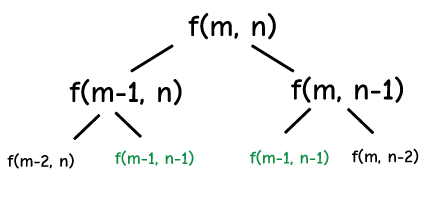Unique Paths
Today, we’ll talk about the unique paths problem.
A robot is located at the top-left corner of a m x n grid. The robot can only move either down or right at any point in time. The robot is trying to reach the bottom-right corner of the grid (marked ‘Finish’ in the diagram below).
How many possible unique paths are there?
Since at any given position, the user can make 2 decisions, the trivial DFS solution will be O(2n) Let’s study some interesting facts that might lead us to a better solution.
Fact 1: Since the robot can only move right or down, all coordinates where m = 0 OR n = 0 are 1. This is because there is only one way to reach those coordinates because they are on the edges of the grid.

Fact 2: The number of unique paths to a position (m, n) is the number of unique paths to position (m – 1, n) plus the number of uniquely paths from position (m, n – 1). This is (m – 1, n) and (m, n – 1) are the only two grid positions where move in one step to (m, n).
This immediately looks like a dynamic programing problem since we have our base case and optimal substructure properties filled.
Overlapping Sub-problem – Yes. We can see that as we break the problem down, we are repeating the subproblems multiple times. To get an idea why, consider the tree of function invocations.

Optimal Substructure – Yes. The optimal solution to f(n) must include the optimal solution to f(m-1, n) and f(m, n-1) otherwise the solution will not be optimal.
Base Case – The base case is when n=0 or m=0 (as mentioned in fact 1).
DP Table
In this problem, our table will be a 2D array of size m by n. Each position (m, n) will hold the maximum number of unique paths to get to (m, n).
Tabulation
class Solution {
public int uniquePaths(int m, int n) {
if (m == 1 && n == 1) {
return 1;
}
int[][] memo = new int[m][n];
for(int i=0; i<m; i++){
memo[i][0]=1;
}
for(int i=0; i<n; i++){
memo[0][i]=1;
}
for(int i=1; i<m; i++){
for(int j=1; j<n; j++){
memo[i][j] = memo[i][j-1] + memo[i-1][j];
}
}
return memo[m-1][n-1];
}
}Conclusion
The unique paths is a fairly straight forward solution with the tabulation method so I’ll omit the recursive memoization method for now.
